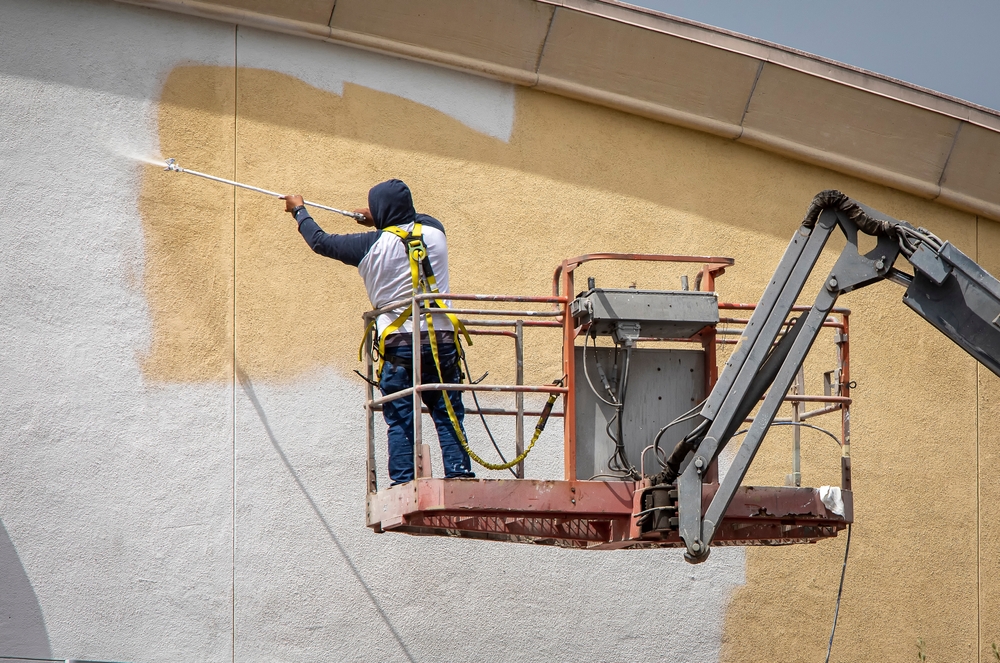Facilities professionals should choose the right type of paint for their commercial, industrial, educational, and governmental buildings, taking into consideration its appearance and durability.

No matter what option you choose, the U.S. Environmental Protection Agency (EPA) recommends reading all instructions, selecting products that don’t emit harmful vapors, and providing adequate ventilation through open windows and exhaust fans.
Here, we’ll look at four types of paint: water-based, oil-based, acrylic, and epoxy.
1. Water-Based Paint
Water-based paint, as the name suggests, uses water instead of oil to carry the pigment and binders of the paint. It’s sometimes referred to as latex or vinyl and should be used on a facility’s exterior walls that are exposed to the elements. It can also be used on interior walls in areas where there’s a lot of moisture, like kitchens and restrooms.
Pros: This type of paint is eco-friendly and has lower levels of toxic emissions, creating less odor. Because it isn’t a hazardous waste product, unlike oil-based paints, not only is it better for those with allergies, but there also are cost savings on hazardous waste disposal. Additionally, it’s durable and dries fast and tends to be cheaper than acrylic.
Cons: Water-based paint takes longer to dry in humidity and lower temperatures and dries too quickly in hot temperatures. Additionally, it doesn’t work well in adverse weather conditions, and its drying time can have a significant impact on its performance and the finished results. It can also become brittle with age and has a lower sheen, or shininess, level.
2. Oil-Based Paint
Oil-based paint is sometimes referred to as alkyd, polyurethane, or varnish. It may be regulated as a “hazardous waste” due to flammability and the presence of regulated solvents such as xylene and toluene. Consider oil-based paint for cabinetry, bookcases, doors, window trim, and baseboards, as well as kitchens, inside high-trafficked facilities.
Pros: Oil-based paint doesn’t fade even under direct sunlight. It works better in harsh environments with temperature swings and does better in high-humidity areas than water-based paints. It’s also durable and can better withstand wear and tear. Additionally, it’s smooth, has a glossy finish, and can be scrubbed.
Cons: Oil-based paint is being phased out because of environmental concerns, such as its higher levels of volatile organic compounds (VOCs), which, according to the American Lung Association, can cause cancer and irritate the eyes, nose, and throat. Also, because of this paint type’s fumes and slow drying time, rooms where it’s used should be well ventilated. Additionally, external surfaces can appear chalky if exposed to UV rays, and latex paint is typically up to 40% cheaper.
3. Acrylic Paint
Acrylic paint is chemical-based and is great for exterior painting, especially for metal buildings. It’s ideal for ceilings and a variety of surfaces like metals, wood, and PVC. Consider this type of paint for commercial buildings that have multi-material ceilings with ventilation and different-colored wirings.
Pros: Acrylic paint will expand and contract as temperatures fluctuate, making it less prone to flaking and cracking. It’s also less toxic than oil-based paints. Additionally, acrylic paints have a wide color palette, and they’re resistant to the sun and easy to clean up, have good adhesion to a wide range of surfaces, and are cheaper than oil-based paints.
Cons: Because the pigment in acrylic paint contains toxins and small amounts of ammonia, it’s harmful to the environment and must be properly disposed of. Additionally, acrylic paint isn’t resistant to UV light and may not hold up over time. Upon application, the paint could dry too fast and can be difficult to remove from absorbent surfaces like carpets.
4. Epoxy Paint
Usually made of a mix of latex acrylic with a small amount of epoxy, epoxy paint is used for industrial purposes, such as warehouses, restrooms, locker rooms, saunas, showrooms, swimming pool areas, and gyms. While epoxy is more expensive than water-based paints, it tends to last longer, so it’s cheaper overall.
Pros: Epoxy resists moisture, heat, chemicals, and oils and helps shield the floor from damage. It’s also easy to clean, corrosion-resistant, and easy to apply to floors and walls.
Cons: UV light can affect epoxy paint and yellow it over time. Although it’s slippery and difficult to remove, it will need to be replaced, as it shows more wear and tear. Also, the application of epoxy paint requires a lot of preparation, is time-consuming, and requires long drying times between coats.
Learn More
Whether you decide to paint your facility with water-based, oil-based, acrylic, or epoxy paint, you should be aware of how your choice could impact VOCs and indoor air quality. To learn more, check out “Managing VOCs and Odors in Commercial Workspaces” on Facilities Management Advisor.
